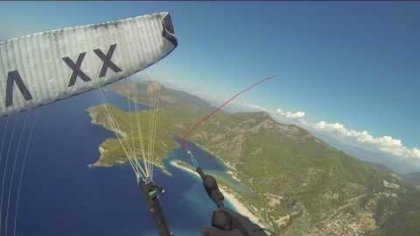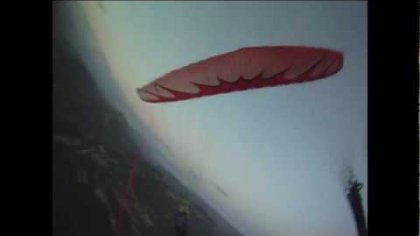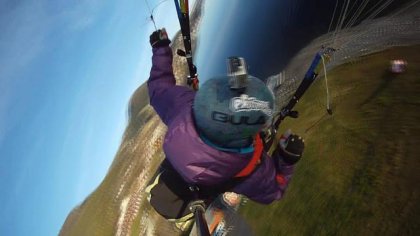19 years ago
Being the most efficient height loosing maneuver the Spiral Dive is the first thing every pilot should master. It will teach you the control of high energy turns, dealing with higher G-forces and many other skills you will require to do other tricks.
'However it’s not really an acro trick, but one of the most essential maneuvers to learn, since it is the best height-losing maneuver. Together with the Full-Stall these are the two most important maneuvering skills for general safety in paragliding.
During a fast Spiral Dive the pilot is at the same level with the glider, while the leading edge is facing the ground and is about parallel with the horizon. The pilot turns very fast around the center of the rotation and the sink rate can reach over 20 m/s. Because the movement is continuous and the speed of rotation is high, the centrifugal forces on the pilot are the most inconvenient of all maneuvers in paragliding. Even though the G-forces can peak much higher in an Asymmetric SAT or a Tumbling but only for short moments and therefore it's a lot easier to handle it.
To be able to keep a deep-spiral going for longer period of time it is necessary to breath and tension muscles in the correct way, that prevents the blood from leaving the head which could ultimately lead to loss of sight or blackout. I will tell you more about this later.
It is extremely important to learn this maneuver progressively! This will be our first experience with higher G-forces and the body needs to get used to it! In the beginning even a steep turn might become pretty uncomfortable. But we just have to keep practicing and our feeling will quickly improve. The other reason why we need to progress step by step is the exit, the most technical part of the maneuver. The more speed there is in the spiral, the higher the amount of energy that we have to deal with when exiting. Coming out from the rotation with too much energy, can cause troubles.'
Improve your skills with Master Acro!
The complete, 14 minutes long tutorial video is available on Master Acro.
Content overview of the Spiral Dive tutorial video:
(0:13) Spiral dive
(2:08) Preparation
(2:42) Enter and maintain
(4:50) Exit
(5:44) Slowing down
(7:23) Killing the remaining energy
(10:23) Dangers
(12:01) Anti-G straining maneuver
(12:46) Differences on acro gliders
(13:28) Key points
ARCHIVE:
Description:
However it’s not an acro manouvre, but pilots who want to fly acro must learn it first.
The Deep Spiral is actually the most effective height-loosing manouvre. During the Spiral the pilot is about at the same level with the glider, while the leading edge is facing to the ground (even in line with the horizon), and the pilot turns very fast around a center near to the canopy. The sinking rate could be more than 20m/s and the pilot’s rotation speed 110 km/h which also generate a significant G-Force.
Enter:
Shift your weight to the right and start to pull down the right brake gradually. The glider start to turn and accelerate into a Spiral. If you pull more brake, the leading edge starts to be facing to the ground and the descent rate increases like hell…
YOU HAVE TO LEARN THIS MANOUVRE PROGRESSIVELY! AT FIRST START PRACTICING ONLY BY DOING STEEP TURNS WITH LESS WEIGHT SHIFTING AND BRAKE INPUT, TO LEARN SAFE HOW TO LEAD IT OUT.
Exit:
Due to the pretty high cross stability of the paraglider construction, if you center yourself and release the brake, usually the glider exit from the Spiral spontaneously in few turns. You can also help it by pulling the outer (left in our case) brake.
BUT!
Many of the gliders, especially with low aspect ratio (DHV 1-1-2) are „spirally unstable”! It means if you release the brake in a fast Deep Spiral (let’s say over 14 m/s) it accelerates more, instead of exit from the spiral, and it doesn’t recover for itself if the pilot doesn’t do anything! It’s called „Nose Down” or „Over The Nose” Spiral. If it happens, pull down the outer brake really hard (perhaps with both hands!), or pump both brakes symmetrically as hard as you can, to get out the glider from the stable position.
Dangers!
The absolutely biggest danger of the Deep Spiral is if you can’t lead it out and you approach to the ground at very high speed (possibly with more than 70 km/h!). IN THIS CASE, IF YOU’RE CLOSER THAN 300 METERS TO THE GROUND, IMMEDIATELY THROW YOUR RESERVE, OTHERWISE YOU WILL PROBABLY DIE, EVEN IF YOU CRASH INTO WATER!!! In a Nose Down Spiral the pilot has to stand up against high G-Forces (possibly over 4 G!) and because of the permanent loading, the blood goes out from the head and it can induce loosing the vision and furthermore black-out, what’s also definitely equal with death!
The DHV test the gliders only up to 14m/s in Deep Spiral, so over this descent rate, the behavior of the glider can be very different!
Anyway, you can also get very big collapses if you lead out the spiral too fast, without bleeding out the energy gradually and you don’t control the situation right.
Be very careful and learn this manouvre gradually!







Latest Comments
helllo friends i found spiral as a very useful maneuver for loosing height, if safely done!! can we enter to wing over when we exit spiral??
hi friends i think its one of the safest maneuver n tried many times n its quite safe if u enter n exit gently
Hallo my friends,i just start to learn fly acro now,and i thing this maneuver it's very good,and have match
energy.